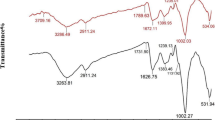Abstract
The effects of jam processing on total phenolics, total flavonoids, total anthocyanins, and antioxidant capacities of fresh Rubus coreanus Miquel (bokbunja) fruits at various pH levels were investigated. Aqueous methanol of 80%(v/v) was found to be the most efficient solvent for extracting phenolics in fruits and jams. More than 90% of total phenolics, antioxidant capacities, and total flavonoids were retained after processing, while approximately 35% of total anthocyanins were lost. Among various pH treatments, jams prepared at pH 2.0–3.0 lost 33–35% of total anthocyanins, while treatments at pH 3.5–4.0 degraded 40–48% of total anthocyanins. Among the various treatments between pH 2.0 and 4.0, jam prepared at pH 3 had the highest sensory scores and overall acceptability. The results suggest that jam making with fruits rich in anthocyanins at lower pH may protect bioactive anthocyanins from thermal processing.
Similar content being viewed by others
References
Konczak I, Zhang W. Anthocyanins-more than nature’s colours. J. Biomed. Biotechnol. 2004: 239–240 (2004)
Kong J-M, Chia L-S, Goh N-K, Chia T-F, Brouillard R. Analysis and biological activities of anthocyanins. Phytochemistry 64: 923–933 (2003)
Lule SU, Xia W. Food phenolics, pros and cons: A review. Food Rev. Int. 21: 367–388 (2005)
Nichenametla SN, Taruscio TG, Barney DL, Exon JH. A review of the effects and mechanisms of polyphenolics in cancer. Crit. Rev. Food Sci. Nutr. 46: 161–183 (2006)
Mateus N, Carvalho E, Carvalho ARF, Melo A, González-Paramás AM, Santos-Buelga C, Silva AMS, de Freitas V. Isolation and structural characterization of new acylated anthocyanin-vinylflavanol pigments occurring in aging red wines. J. Agr. Food Chem. 51: 277–282 (2002)
Robards K, Antolovich M. Analytical chemistry of fruit bioflavonoids: A review. Analyst 122: 11R–34R (1997)
Antolovich M, Prenzler P, Robards K, Ryan D. Sample preparation in the determination of phenolic compounds in fruits. Analyst 125: 989–1009 (2000)
Giusti MM, Wrolstad RE. Acylated anthocyanins from edible sources and their applications in food systems. Biochem. Eng. J. 14: 217–225 (2003)
da Costa CT, Horton D, Margolis SA. Analysis of anthocyanins in foods by liquid chromatography, liquid chromatography-mass spectrometry and capillary electrophoresis. J. Chromatogr. A 881: 403–410 (2000)
Cooper-Driver GA. Contributions of Jeffrey Harborne and coworkers to the study of anthocyanins. Phytochemistry 56: 229–236 (2001)
Heo S, Lee D-Y, Choi H-K, Lee J, Kim J-H, Cho S-M, Lee HJ, Auh J-H. Metabolite fingerprinting of bokbunja (Rubus coreanus Miquel) by UPLC-qTOF-MS. Food Sci. Biotechnol. 20: 567–570 (2011)
Wrolstad RE, Durst RW, Lee J. Tracking color and pigment changes in anthocyanin products. Trends Food Sci. Tech. 16: 423–428 (2005)
Thompson MM. Survey of chromosome numbers in Rubus (Rosaceae: Rosoideae). Ann. Miss. Bot. Gard. 84: 128–164 (1997)
Choi H-S, Kim M-K, Park H-S, Kim Y-S, Shin D-H. Alcoholic fermentation of Bokbunja (Rubus coreanus Miq.) wine. Korean J. Food Sci. Technol. 38: 543–547 (2006)
Downing DL. Preserves (jams), jellies and related products. pp. 385–426. In: A Complete Course in Canning and Related Processes — Book III Processing Procedures for Canned Food Products. CTI Publications, Inc., Baltimore, MD, USA (1996)
Patras A, Brunton NP, O’Donnell C, Tiwari BK. Effect of thermal processing on anthocyanin stability in foods; mechanisms and kinetics of degradation. Trends Food Sci. Tech. 21: 3–11 (2010)
Kim EO, Lee H, Cho CH, Kim YJ, Kim D-O. Antioxidant capacity and anti-inflammatory effect of the ethyl acetate fraction of dried persimmon (Diospyros kaki Thumb.) on THP-1 human acute monocytic leukemia cell line. J. Korean Soc. Appl. Biol. Chem. 54: 606–611 (2011)
Singleton VL, Rossi JA Jr. Colorimetry of total phenolics with phosphomolybdic-phosphotungstic acid reagents. Am. J. Enol. Vitic. 16: 144–158 (1965)
Jia Z, Tang M, Wu J. The determination of flavonoid contents in mulberry and their scavenging effects on superoxide radicals. Food Chem. 64: 555–559 (1999)
Giusti MM, Wrolstad RE. Characterization and measurement of anthocyanins by UV-visible spectroscopy. pp F1.2.1–F1.2.13. In: Current Protocols in Food Analytical Chemistry. Wrolstad RE (ed). John Wiley & Sons, Inc., New York, NY, USA (2001)
van den Berg R, Haenen GRMM, van den Berg H, Bast A. Applicability of an improved Trolox equivalent antioxidant capacity (TEAC) assay for evaluation of antioxidant capacity measurements of mixtures. Food Chem. 66: 511–517 (1999)
Brand-Williams W, Cuvelier ME, Berset C. Use of a free radical method to evaluate antioxidant activity. LWT-Food Sci. Technol. 28: 25–30 (1995)
Kim D-O, Padilla-Zakour OI. Jam processing effect on phenolics and antioxidant capacity in anthocyanin-rich fruits: Cherry, plum, and raspberry. J. Food Sci. 69: S395–S400 (2004)
García-Viguera C, Zafrilla P, Romero F, Abellán P, Artés F, Tomás-Barberán FA. Color stability of strawberry jam as affected by cultivar and storage temperature. J. Food Sci. 64: 243–247 (1999)
Kırca A, Özkan M, Cemeroğlu B. Effects of temperature, solid content and pH on the stability of black carrot anthocyanins. Food Chem. 101: 212–218 (2007)
Mok C, Hettiarachchy NS. Heat stability of sunflower-hull anthocyanin pigment. J. Food Sci. 56: 553–555 (1991)
Author information
Authors and Affiliations
Corresponding author
Rights and permissions
About this article
Cite this article
Lee, D.J., Lee, H., Lee, SH. et al. Effects of jam processing on anthocyanins and antioxidant capacities of Rubus coreanus Miquel berry. Food Sci Biotechnol 22, 1607–1612 (2013). https://doi.org/10.1007/s10068-013-0257-8
Received:
Revised:
Accepted:
Published:
Issue Date:
DOI: https://doi.org/10.1007/s10068-013-0257-8




